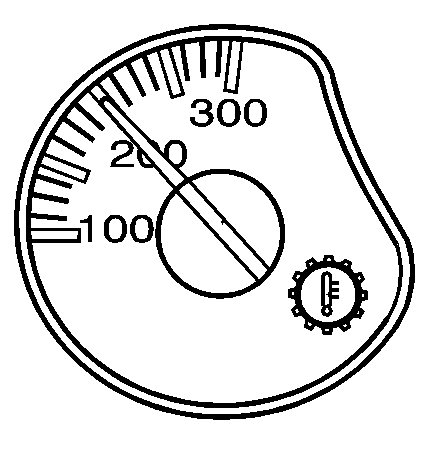United States

Canada

Your vehicle may have a transmission temperature gage.
When your ignition is on, the gage shows the temperature of the transmission fluid. The normal operating range is from 100°F (38°C) to about 265°F (130°C).
At approximately 265°F (130°C), the Driver Information Center (DIC) will display a TRANSMISSION HOT message and the transmission will enter a transmission protection mode. When the transmission enters the protection mode, you may notice a change in the transmission shifting patterns. The transmission will return to normal shifting patterns when the transmission fluid temperature falls below 260°F (125°C).
See Driver Information Center (DIC) for further information.
If your vehicle has an Allison® transmission, and the fluid reaches temperatures of approximately 275°F (135°C) or greater, the DIC will display a TRANS HOT IDLE ENGINE warning message and a chime will sound until the temperature falls below 265°F (130°C). Pull the vehicle off the roadway when it is safe to do so. Set the parking brake, place the transmission in PARK (P) and allow the engine to idle until the transmission temperature falls below 265°F (130°C). If the transmission continues to operate above 265°F (130°C), contact your nearest dealer or the GM Roadside Assistance Center. See Roadside Assistance Program .
Notice: If you drive your vehicle with the transmission temperature gage above normal operating range, you can damage the transmission. This could lead to costly repairs that would not be covered by your warranty. Do not drive your vehicle while the transmission temperature gage reading is above normal. See your dealer for service.
The following situations can cause the transmission to operate at higher temperatures:
| • | Towing a trailer |
| • | Hot outside air temperatures |
| • | Hauling a large or heavy load |
| • | Low transmission fluid level |
| • | High transmission fluid level |
| • | Restricted air flow to the radiator and the auxiliary transmission oil cooler, if equipped. |
A temporary solution to reduce hotter transmission operating temperatures may be to let the transmission cool down. If the transmission is operated at higher temperatures on a frequent basis, see Scheduled Maintenance for the proper transmission maintenance intervals.
